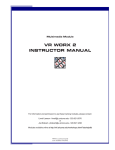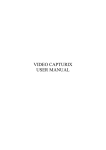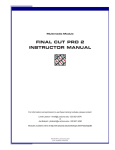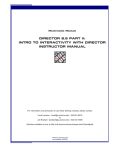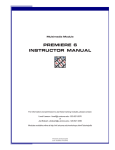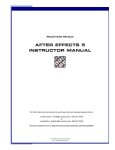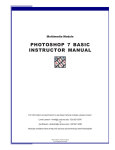Download qtvr authoring studio instructor manual - UITS
Transcript
Multimedia Module QTVR AUTHORING STUDIO INSTRUCTOR MANUAL For information and permission to use these training modules, please contact: Limell Lawson - [email protected] - 520.621.6576 or Joe Brabant - [email protected] - 520.621.9490 Modules available online at http://mll.arizona.edu/workshops.shtml?tutorialpdfs QTVRAuthoring_Instructor.pmd Last modified: 05/20/02 2 QTVR AUTHORING STUDIO: Instructor Manual TABLE OF CONTENTS Instructor Setup ............................................................................................................................. 3 Introduction and Overview .............................................................................................................. 5 Lecturette 1: The QTVR Panorama ................................................................................................ 6 Lecturette 2: The QTVR Object ...................................................................................................... 8 Lecturette 3: The QTVR Scene ...................................................................................................... 9 Exercise 1: Prepare Images for Importing .................................................................................... 10 Exercise 2: Add Images to the Panorama Stitcher ....................................................................... 11 Exercise 3: Select Correct Lens .................................................................................................. 12 Exercise 4: Set Correct Image Alignment .................................................................................... 13 Lecturette 4: The Authoring Studio Files ...................................................................................... 13 Exercise 5: Check Movie and Playback Settings ......................................................................... 14 Exercise 6: Set Playback Settings .............................................................................................. 15 Exercise 7: Using the Panorama Maker ....................................................................................... 16 Exercise 8: Create and Add Nodes to a Scene Maker Document ................................................ 17 Exercise 9: Linking Nodes in the Scene Maker ........................................................................... 17 Exercise 10: Defining Hot Spots for the “Stitch” Panorama .......................................................... 18 Exercise 11: Defining Hot Spots for the “PanoMake” Panorama .................................................. 19 Exercise 12: Check Settings and Make Scene ............................................................................ 19 Criterion Test................................................................................................................................ 20 File name: QTVRAuthoring_Instructor.pmd Last modified: 05/20/02 Copyright Arizona Board of Regents, 2002 University of Arizona 3 QTVR AUTHORING STUDIO: Instructor Manual INSTRUCTOR SETUP: Materials: ♦ ♦ ♦ ♦ ♦ QTVR Authoring Studio Instructor Manual with disk of accompanying files QTVR Authoring Studio User Manual (1 copy per user) 2 Job Aids (1 copy per user) Several pieces of blank paper Scotch tape Equipment:: ♦ ♦ ♦ ♦ ♦ ♦ Electronic Classroom Macintosh workstations (1 per user) QTVR Authoring Studio, QuickTime player, and a web browser installed Instructor Mac workstation with QTVR Authoring Studio, QuickTime player, and a web browser installed Overhead projector connected to instructor workstation Digital Still Camera, QTVR panning head, Tripod (optional items, only if available to instructor Flip Chart and markers Setup: ♦ ♦ ♦ ♦ ♦ ♦ ♦ ♦ Session length is approximately 2 hours Instructor should be familiar with all aspects/components of this QTVR Authoring Studio module Check that all computers and equipment are functioning properly Turn on and test projector Prepare flip chart of key points/items to be covered. Make sure view is unobstructed Have users sit at their own computer Copy the “Images for Stitching” folder and the Apple Icon Garden.pict to the desktops of each computer, including Instructor computer Open a web browser and leave the following windows open for the lesson: ♦ ♦ ♦ ♦ ♦ FOR PANORAMA: http://www.apple.com/quicktime/products/gallery/paris.html FOR OBJECT: http://www.apple.com/hardware/gallery/imacdots0222_320.html FOR SCENE: http://mll.arizona.edu/hardware.shtml?qtvr.one The Instructor Manual is set up so that you can see the corresponding User Manual page next to it. To make copies of the User Manual for the participants of the workshop, print out the PDF version from http://mll.arizona.edu/workshops.shtml?tutorialpdfs When teaching this module, make sure you demonstrate steps and ideas for the users FIRST. Do not allow them to follow along on their own while you are demonstrating; they will have the opportunity to practice steps on their own after. Be sure to go through ALL material, as the users may not have all of the information in their User Manuals File name: QTVRAuthoring_Instructor.pmd Last modified: 05/20/02 Copyright Arizona Board of Regents, 2002 University of Arizona 4 QTVR AUTHORING STUDIO: Instructor Manual Flip Chart Preparation: ♦ Page #1: QTVR Panorama ♦ ♦ ♦ ♦ ♦ Page #2: QTVR Object ♦ ♦ ♦ ♦ ♦ Def. A QTVR Panorama lets you view an environment, such as a room or an outdoor vista, from a variety of angles. Equipment needed: Tripod, QTVR Pan Head, Camera (Film, Digital, or Video) 40-50% overlap between images For a full panorama: 360 / # of images = Degrees Between Images Def. A QTVR Object lets you view a three-dimensional object, such as a cell phone, a statue, or a computer from a variety of angles. Equipment needed: Tripod, QTVR Pan Head, Camera, Lazy Susan or motorized rig. ROWS: The number of images shot in the vertical plane (up and down) of the object make up the number of rows of the object. COLUMNS: The number of images shot in the horizontal plane (side to side) of the object make up the number of columns of the object. Page #3: QTVR Scene Terms ♦ ♦ Def. A QTVR Scene is a collection of QTVR panoramas, objects, and other media. HOT SPOTS: areas in a node that when clicked on are linked to the other nodes of the scene. File name: QTVRAuthoring_Instructor.pmd Last modified: 05/20/02 Copyright Arizona Board of Regents, 2002 University of Arizona 5 QTVR AUTHORING STUDIO: Instructor Manual INTRODUCTION AND OVERVIEW Instructor Note: At this time, pass out the User Manual to the students. Indicate that the students are Not to get ahead and do anything without the instructor. Indicate that the students are Not to do anything on the computer besides the indicated tasks at the indicated times. Remind them that they are to watch you first as you demonstrate, then they will be able to practice on their own. In this class you will learn the basic layout and key terms to using the QuickTime Virtual Reality Authoring Studio. We will cover basic QuickTime Virtual Reality concepts, such as equipment setup and shooting, and the various types of QTVR media, and show how to create this media using the QTVR Authoring Studio interface. We will go over importing into the Authoring Studio, stitching, panorama creation, and scene creation. Output to the web and CD-Rom will also be covered. File name: QTVRAuthoring_Instructor.pmd Last modified: 05/20/02 Copyright Arizona Board of Regents, 2002 University of Arizona 6 QTVR AUTHORING STUDIO: Instructor Manual LECTURETTE 1: THE QTVR PANORAMA Instructor’s Note: Make sure flip chart is opened to Page #1, and you have the several pieces of blank paper and tape. Ensure that your computer hooked up to the projector has the web pages opened so you can quickly get to them. For this, and the next couple of sections, we will go through and define much of the terminology of a QuickTime Virtual Reality project. Using examples you will be able to clearly understand what these terms are. We all know that you will not be expected to actually go out there and shoot a QTVR project. However, having an understanding of what goes on will allow you to help the ILC client in a more useful manner. A QTVR Panorama lets you view an environment, such as a room or an outdoor vista, from a variety of angles. A full panorama can be panned horizontally 360 degrees to provide the illusion that you are standing in the center of the panorama. Note: Not all panoramas have to be 360 degrees; some could be, say only 180 degrees. Here is an example of a QTVR panorama. Instructor’s Note: Show the users the web site example of the panorama and demonstrate the following points. You can view a QTVR panorama by pressing the mouse button and dragging the pointer over the image in the direction you want to view. You can also zoom in on parts of the image for a closer look by clicking the zoom button in the lower left area of the play back window. Instructor’s Note: If you have the optional QTVR gear, show them to the users as you discuss the following information. To make a QTVR Panorama, a camera, a special panning head, and tripod are placed in the center of the environment and a picture is taken at each appropriate DEGREE mark, rotating around the focal point of the lens. The special panning head is what rotates the camera and has markings in degrees for the photographer to use. Conversely, you can take one panoramic image and have the QTVR software wrap the edges together. The number of images you need to take depends on the size of lens your camera uses. Basically, you want to take enough images so that from one shot to the next, you have about a 40-50 percent overlap. Instructor’s Note: At this point, arrange the individual pieces of paper so they are overlapping by about half and tape them together. Just tape enough so they get the idea of how the images get “stitched” together in the software. You need this overlap so the Studio can properly align and stitch the two together. The most common numbers of images to take are either 12 or 18, again depending on what size lens your camera has. So, depending on the number of images you have to take, you know how much, in DEGREES, to rotate the camera. For example: If I know I need to take 18 images, and I want a 360 panorama, 360 divided by 18 is 20 degrees. I must therefore take a picture every 20 degrees in order to make that 360. The QTVR pan head has the degree markings on it so you don’t have to guess. Here is a job aid that will help you determine how many images to take with different camera lenses. Instructor’s Note: Pass out job aid #1 to the users. Ask the users if there are any questions. Also, ask the following questions to them for review. File name: QTVRAuthoring_Instructor.pmd Last modified: 05/20/02 Copyright Arizona Board of Regents, 2002 University of Arizona 7 QTVR AUTHORING STUDIO: Instructor Manual QUESTIONS FOR REVIEW: Q: If I were taking 12 images to make a 180-degree panorama, how many degrees would be in between each image? A: 180 degrees/12 images = 15 degrees in between Q: What are the three pieces of equipment needed for a QTVR Panorama Shoot? A: A camera, a QTVR pan head, and a tripod Now that we have discussed what a panorama is, let us turn our attention to the QTVR object. File name: QTVRAuthoring_Instructor.pmd Last modified: 05/20/02 Copyright Arizona Board of Regents, 2002 University of Arizona 8 QTVR AUTHORING STUDIO: Instructor Manual LECTURETTE 2: THE QTVR OBJECT Instructor’s Note: Turn flip chart to page #2. A QTVR Object lets you view a three-dimensional object, such as a cell phone, a statue, or a computer from a variety of angles. It gives you the illusion that you are holding the object and are manipulating it by rotating it. Here is an example of a QTVR object on the web. Instructor’s Note: Display the web page for the OBJECT on the overhead. To rotate an object, click on the image and drag the mouse horizontally left or right. The object is made from a series of images that are stitched together in the QTVR software. Using a manual or motorized rig to take the images from all angles of the object, and in sequence, yield the best results. The number of images shot in the vertical plane (up and down) of the object make up the number of ROWS of the object. The number of images shot in the horizontal plane (side to side) of the object make up the number of COLUMNS of the object. Look at the illustration of rows and columns in your user manual. Instructor’s Note: Allow a few seconds for the participants to locate the illustration and look it over. If you don’t have access to a motorized rig, placing your object on a simple “lazy Susan” and rotating it while the camera is stationary can yield a good object. For objects, there is not as much concern with what type of lens you use and how many images you must take. However many images you do take for one row however, remember to divide that it by 360 to get the number of degrees between each image. The more pictures you take, the better quality of motion you will get when rotating your final object. Keep in mind though that more images equals larger file size, so if your object was going to the web, you would want to limit the number of images you took. Instructor’s Note: Ask the users if there are any questions. Also, ask the following questions to them for review. QUESTIONS FOR REVIEW: Q: Why do you suppose more images of the object is better than fewer? A: Because having more shots will yield a much smoother motion when rotating the object. There are more angles of the object that are covered. File name: QTVRAuthoring_Instructor.pmd Last modified: 05/20/02 Copyright Arizona Board of Regents, 2002 University of Arizona 9 QTVR AUTHORING STUDIO: Instructor Manual LECTURETTE 3: THE QTVR SCENE Instructor’s Note: Turn flip chart to page #3 A QTVR Scene is a collection of QTVR panoramas, objects, and other media. Each media element in a scene is called a NODE. A scene looks just like a panorama, but unlike a simple panorama, you can interact with parts of the scene. Scenes have HOT SPOTS which are areas in a node that are linked to the other nodes of the scene. For example, a hot spot in a computer lab scene could link to another room in the lab (another node), or it could allow you to manipulate one of the computers in the lab (yet another node). These hot spots can also link to Web Sites and a variety of other media. Here is an example of a QTVR scene on the web. Instructor’s Note: Display the web page for the SCENE on the overhead. When your mouse rolls over a Hot Spot, the cursor icon changes. Point this out to the users so they are aware of how to locate the Hot Spots. Click on the Hot Spot so it can take you to another node. Creating the scene and hot spots are done in QTVR Authoring Studio. Further in today’s lesson, we will go over how to make a hot spot using the nodes we will make. Instructor’s Note: Ask the users if there are any questions. Also, ask the following questions to them for review. QUESTIONS FOR REVIEW: Q: Why would one want to create a QTVR scene? A: INTERACTIVITY! Adding hot spots allows the user to have a more interactive experience with the panoramas and objects. Also, it’s a nice way to bring all of the nodes you have created together in an interesting way. Q: In the computer lab example of a scene, what were some of the hot spots we saw? A: The computer stations, the area leading to the other side of the room. You all now have a pretty good grasp of some of the terminology that we will be using for the rest of the lesson. Now lets turn to actually importing images into and using QuickTime Virtual Reality Authoring Studio. File name: QTVRAuthoring_Instructor.pmd Last modified: 05/20/02 Copyright Arizona Board of Regents, 2002 University of Arizona 10 QTVR AUTHORING STUDIO: Instructor Manual EXERCISE 1: PREPARE IMAGES FOR IMPORTING Instructor Note: Remember to demonstrate first, then allow the users to complete the exercise on their own, following the steps in their User Manuals. Steps: 1. Create a new folder for the images on the hard drive It is important to group the images in a folder as opposed to leaving them scattered in the hard drive. If they are not, you will not be able to simply add them all at once to the program because there could be other files you do not want. 2. Copy the images from the disk (zip, flash card, cd-rom, etc.) to the folder For our lesson I have already copied the files needed to each of your workstations. But this is just a reminder that you must have them copied off of the disk. NEVER work off the disk, as doing so will cause a slower run time and could possibly crash the computer. 3. Ensure image files are named in an ordered alphanumeric format The alphanumeric format will again simplify adding the images to the program later, as they will be in the correct order you want. Remember, however to have double digits of numbers. For example, Picture1 is not acceptable, but Picture01 is. Why? Because if you had 10 images or more, naming them the first way will order them like: Picture1, Picture10, Picture2, Picture3, etc. Naming them with double digits will result in: Pic01, Pic02…Pic10 Each of you will find the files at your workstation in a folder called Images for Stitching. Since they are already copied you will not have to do that step, but go through and make sure that they are ready for importing into the Studio, such as ensuring their naming sequence is correct. You will have 1 minute to complete this check. Instructor Note: Allow the users one minute to do this. After they have finished, ask if there are any questions. Also, ask the following questions to them. QUESTIONS FOR REVIEW: Q: How will you help a client who has their images on a disk in no order whatsoever? A: View each image to determine which comes before which, then rename them with alphanumeric names. Q: Other than a disk, how else might a client bring in their images? A: Flash card, digital camera, negatives to scan… File name: QTVRAuthoring_Instructor.pmd Last modified: 05/20/02 Copyright Arizona Board of Regents, 2002 University of Arizona 11 QTVR AUTHORING STUDIO: Instructor Manual EXERCISE 2: ADD IMAGES TO THE PANORAMA STITCHER Instructor Note: Remember to demonstrate first, then allow the users to complete the exercise on their own, following the steps in their User Manuals. Steps: 1. Open QTVR Authoring Studio 2. Select File -> New -> Panorama Stitcher. First we will import the multiple images, which means we must choose Panorama Stitcher. It is called so because we will in a sense be sewing together each of the individual images to make one panorama. Note the other options on the menu as well: Object Maker – For stitching images for an object. Panorama Maker – For one single panoramic image. Project Manager – Sets up and organizes large QTVR projects. Scene Maker – For creating a scene out of different nodes. We will cover the Panorama Maker, and Scene Maker later in the lesson. 3. Save the file on the desktop and name it “stitch”. 4. Click the add images button You can use images that are in a format supported by QuickTime, such as PICT, TIFF, JPEG, and GIF. 5. Locate the folder containing the images to be stitched and open it Again, the images are in the folder called “Images for Stitching”. 6. Click Add all, then OK Here we see how keeping the set of images in its own folder simplifies this process. 7. Click on the left or right rotate buttons to orient the images right side up Instructor Note: Ask if there are any questions. Also, ask the following questions to them. QUESTIONS FOR REVIEW: Q: What is the difference between the Panorama Maker option and the Panorama Stitcher option? A: Panorama Maker only takes one image and wraps it to create the panorama. The Panorama Stitcher takes a series of images and “stitches” them together side by side to create the panorama. Q: Why bother rotating the images once in the studio? A: Because the images are stitched side by side. If they were all sideways, they would be stitched incorrectly. File name: QTVRAuthoring_Instructor.pmd Last modified: 05/20/02 Copyright Arizona Board of Regents, 2002 University of Arizona 12 QTVR AUTHORING STUDIO: Instructor Manual EXERCISE 3: SELECT CORRECT LENS Instructor Note: Remember to demonstrate first, then allow the users to complete the exercise on their own, following the steps in their User Manuals. Steps: 1. Obtain the size of lens of camera used to shoot images from the user In order for the Authoring Studio to automatically align and stitch your images properly, you will have to enter the correct information regarding the lens length of the camera used to shoot the pictures. 2. Find the 35 mm equivalent of the lens, if it’s a digital camera, (see job aid) If a digital camera was used, as opposed to a 35 mm film camera, you will have to find the 35 mm equivalent of that lens. Use this job aid to help you in determining this equivalent. Instructor Note: Point out that the lens conversion table is on the Job Aid that you passed out earlier. For the images we will be using today, they were shot using an 18mm film lens. 3. Click on the LENS drop down menu and select the 18mm Portrait option Depending on the lens the ILC client used, you might not find the right lens in this drop down menu. So just in case, let’s go through the steps to create a new lens. To demonstrate these steps, we will delete the existing 18mm option and recreate it. 4. Click the lens drop down menu, and select the EDIT option. 5. Highlight the 18mm Portrait option. Then click on the delete button. 6. Click the new button. Go ahead and type “18mm Portrait” in the Lens Name box. 7. Enter the focal length of the lens in the focal length box. Type 18 in this box. 8. Click the calculate button. This will help you calculate the Vertical Field of View of the lens. The Lens Calculator window opens. The vertical angle of view values will be calculated based on the information given. Click the Use button next to the orientation of the images, Portrait or Landscape. For this lesson, click the portrait use button. 9. Select the correct film type in the film drop down menu. In this case, the camera used was a 35 mm, so ensure that is the selection. If it was a digital camera, you would have selected “other” and entered the correct width and height values in the appropriate boxes. 10. Click the calculate button. File name: QTVRAuthoring_Instructor.pmd Last modified: 05/20/02 Copyright Arizona Board of Regents, 2002 University of Arizona 13 QTVR AUTHORING STUDIO: Instructor Manual 11. Enter “30” in recommended degrees between images. Remember, we have 18 images, so there are 30 degrees between each image if we are to make a 360-degree panorama. 12. Click done. This returns you to the main interface of QTVR Authoring Studio. Make sure the 18mm Portrait lens is selected in the lens drop down menu. EXERCISE 4: SET CORRECT IMAGE ALIGNMENT Instructor Note: Remember to demonstrate first, then allow the users to complete the exercise on their own, following the steps in their User Manuals. Steps: 1. Click “Image Alignment” tab If you look above the image alignment tab, it is already set to 30 degrees between images. However, if you needed to change it, you can do it by clicking the image alignment tab and entering the appropriate information. 2. Enter the appropriate number of degrees in the degrees between images box. Again, 30 is already in the box, so no need to change it. Go I will go ahead and just click DONE. LECTURETTE 4: THE AUTHORING STUDIO FILES Next I would like to draw your attention to the top of the interface window. There are three file options with check boxes next to them called PICT, TILE, and PANO respectively. Refer to the chart in your user manual by section 2.4 to learn the differences between these files. I will give you a couple of minutes to look at the chart. Instructor Note: Allow the users about 2 minutes to look over the chart. It is highly recommended to keep these 3 files checked. This means that QTVR Authoring Studio will save these intermediate files so it will not have to remake them entirely if you change settings and stitch your panorama several times. As we keep working to the right of the interface, let’s check our panorama settings next. File name: QTVRAuthoring_Instructor.pmd Last modified: 05/20/02 Copyright Arizona Board of Regents, 2002 University of Arizona 14 QTVR AUTHORING STUDIO: Instructor Manual EXERCISE 5: CHECK MOVIE AND PLAYBACK SETTINGS Instructor Note: Remember to demonstrate first, then allow the users to complete the exercise on their own, following the steps in their User Manuals. Steps: 1. Click the Settings button, then click the Compression tab. We are jumping to the compression tab because you can usually leave the other options selected to their defaults. We will just go over the settings that you should always check change as needed. 2. Click the Settings button within the Compression tab. For our purposes today, we will adjust the settings for output to the web. Depending on the final output, the settings may vary. Refer to this job aid for the movie and playback settings for the web, cd-rom, and kiosk. Instructor Note: Pass out job aid #2 - the Movie and Playback settings job aid 3. Click on the drop down menu of compressors. Choose photo-jpeg. 4. On the quality scale, move the indicator to halfway between “low” and “med”. Click OK. 5. Select the Playback tab. 6. Enter 320 for the panorama viewing size width, and 240 for the panorama viewing size height. 7. Select the Imaging tab 8. Set the quality in the static box to normal The static settings affect the panoramic image when it is not moving. The motion settings affect the panoramic image while the viewer is moving it. 9. Set the quality in the motion box to low 10. Select the File tab 11. Ensure the flatten to data fork box is checked If you do not flatten the movie, your file will not play on Windows computers. Also, files that are not flattened will require the tile file to be in the same location as the pano movies file, or else they will not play. 12. Click OK. 13. Click the Stitch Pano button to stitch your movie! File name: QTVRAuthoring_Instructor.pmd Last modified: 05/20/02 Copyright Arizona Board of Regents, 2002 University of Arizona 15 QTVR AUTHORING STUDIO: Instructor Manual EXERCISE 6: SET PLAYBACK SETTINGS Instructor Note: Remember to demonstrate first, then allow the users to complete the exercise on their own, following the steps in their User Manuals. All of you should now see a window with your finished panorama movie. Double check the picture in your handouts and make sure that is what you see. The software allows you to be able to specify the exact location of the movie to be oriented to when the file opens up. Go ahead and place your mouse over the movie and scroll around it. Notice the values in the boxes in the top right corner are changing. These values tell the software exactly which location in degrees you are scrolling over, and exactly at what tilt you are viewing the movie. We will set our playback settings so when this movie is opened by any user, they will be oriented at a certain point. Steps: 1. Scroll to the location in the movie where it is to automatically be oriented to. For our example, scroll to the location where you see the checkout stand. 2. Click the “Set Playback Settings” button 3. Click yes to remake the panorama with the new settings 4. Save your files. That’s it! We’re finished with creating our panorama using the Panorama Stitcher! At this point you should have a panorama movie file on the desktop called “Stitch”. This is the file that you will again, put on the web, or burn to CD-Rom, or what have you. One note: ensure that this file has the .mov extension in its file name. Now we will go through how to make a panorama using a panoramic image, and the Panorama Maker option. File name: QTVRAuthoring_Instructor.pmd Last modified: 05/20/02 Copyright Arizona Board of Regents, 2002 University of Arizona 16 QTVR AUTHORING STUDIO: Instructor Manual EXERCISE 7: USING THE PANORAMA MAKER Instructor Note: Remember to demonstrate first, then allow the users to complete the exercise on their own, following the steps in their User Manuals. Steps: 1. Select file -> new -> Panorama Maker 2. Save file as PanoMake 3. Click the add image button As we learned earlier, you can use any image that is in a format supported by QuickTime, such as PICT, TIFF, JPEG, and GIF. 4. Locate and open the file named Apple icon Garden.pict on the desktop 5. Rotate the image, if necessary Instructor Note: At this point allow the users to repeat these previous 5 steps before continuing with the rest. Make note of the differences between the Panorama Maker interface compared to the Panorama Stitcher, for example, we do not need to enter any information regarding the type of lens used to take the image, and there is no intermediate PICT file being created, as there is no stitching process in the Panorama Maker. 6. Click the Settings button, then click the Compression tab. 7. Click the Settings button within the Compression tab. 8. Click on the drop down menu of compressors. Choose photo-jpeg. 9. On the quality scale, move the indicator to halfway between “low” and “med”. Click OK. 10. Select the Playback tab. 11. Enter 320 for the panorama viewing size width, and 240 for the panorama viewing size height. 12. Select the Imaging tab. 13. Set the quality in the static box to normal. 14. Set the quality in the motion box to low. 15. Select the File tab. 16. Ensure the flatten to data fork box is checked. 17. Click OK. 18. Click the Stitch Pano button to make your panorama! File name: QTVRAuthoring_Instructor.pmd Last modified: 05/20/02 Copyright Arizona Board of Regents, 2002 University of Arizona 17 QTVR AUTHORING STUDIO: Instructor Manual The playback window opens, just like when we were stitching our previous panorama. You can set the playback settings here just like you did then as well. We will not worry about that part for this panorama. So simply save your files and ensure that the PanoMake movie file has a .mov extension. At this point, we have made 2 QuickTime Virtual Reality panoramas. Now let us learn how to use the Scene Maker to create hot spots and add more interactivity to these panoramas. EXERCISE 8: CREATE AND ADD NODES TO A SCENE MAKER DOCUMENT Instructor Note: Remember to demonstrate first, then allow the users to complete the exercise on their own, following the steps in their User Manuals. Steps: 1. Select file -> new -> scene maker 2. Save file as “scene” and save it to the desktop. The Scene Maker interface window pops up. 3. Drag and drop the movie files “Stitch” and “PanoMake” from the desktop into the white area of the scene maker window. 4. Click the URL node button on the create node toolbar. It looks like a little globe. 5. Position your mouse anywhere in the white working space of the window and click once. A URL node should now be in your working space. 6. Double click on the url node. Enter http://www.arizona.edu in the text box and click OK. 7. Rename the “untitled” url node to say “Url- U of A” To do this, click on the URL node once and type the information in when the “untitled” is highlighted. EXERCISE 9: LINKING NODES IN THE SCENE MAKER Instructor Note: Remember to demonstrate first, then allow the users to complete the exercise on their own, following the steps in their User Manuals. Steps: 1. Click the single link button The single link button is the button whose icon is a single arrow. It is located next to a button whose icon is a set of 2 arrows – which the dual link button. The reason why we only need a single link from the Stitch file to the URL is because we cannot make a hot spot on another person’s web page to get back to our panorama. File name: QTVRAuthoring_Instructor.pmd Last modified: 05/20/02 Copyright Arizona Board of Regents, 2002 University of Arizona 18 QTVR AUTHORING STUDIO: Instructor Manual 2. Press and hold the mouse button over the “stitch.mov” node and drag the line to the “U of A URL” node. When the “URL- U of A” is highlighted, release the mouse. You should see an arrow link going from the first node to the second. 3. Click the dual link button. We now want to use a dual link because we want to create hot spots that will take us back and forth between these two nodes. 4. Press and hold the mouse button over the “stitch” button and drag the link to the “PanoMake” node. We use the dual link in this case because we want to be able to travel back and forth between these two nodes, as opposed to the single link to the URL. EXERCISE 10: DEFINING HOT SPOTS FOR THE “STITCH” PANORAMA Instructor Note: Remember to demonstrate first, then allow the users to complete the exercise on their own, following the steps in their User Manuals. Steps: 1. Click on the stitch.mov node, ensuring no other node is highlighted as well. 2. Press and hold the mouse button to bring up a menu. Select “edit hot spots.” The Hot Spot Editor window pops up, as well as the image of the panorama. 3. Click on the “panoMake” option in the hot spot editor to highlight it. Now, whatever hot spots we create while PanoMake is highlighted, when clicked on, will take us to our Pano Make panorama. 4. Click on the solid colored rectangle located at the top of the hot spot editor. This is the selector with which you will draw the hot spot on the image of the panorama. Depending on what you want to have a hot spot attached to it, you might want to use the other shapes. 5. Locate the double doors in the “Stitch” node. Press and hold the mouse button and draw a rectangle to cover the entire doorway. Again, when a user will click on this doorway, they will be taken to the PanoMake panorama. 6. Click on the URL- U of A option in the hot spot editor to highlight it. 7. Click on the solid colored rectangle again. 8. Locate the cashier/checkout area in the panorama. Press and hold the mouse button and draw a rectangle to cover the entire checkout station. 9. Click File-> Save to save the hot spot file and close the hot spot windows to return to the scene maker window. File name: QTVRAuthoring_Instructor.pmd Last modified: 05/20/02 Copyright Arizona Board of Regents, 2002 University of Arizona 19 QTVR AUTHORING STUDIO: Instructor Manual EXERCISE 11: DEFINING HOT SPOTS FOR THE “PANOMAKE” PANORAMA Instructor Note: Remember to demonstrate first, then allow the users to complete the exercise on their own, following the steps in their User Manuals. Steps: 1. Click the “PanoMake” node to highlight it, ensuring no other node is highlighted as well. 2. Press and hold the mouse button to bring up a menu. Select “edit hot spots.” 3. Click on the “stitch” option in the hot spot editor to highlight it. 4. Click on the solid colored rectangle located at the top of the hot spot editor. 5. Locate the office building (any part of it will do) in the panorama. Press and hold the mouse button and draw a rectangle to cover a portion of the building. 6. Click File-> Save to save the hot spot file and close the hot spot windows to return to the scene maker window. EXERCISE 12: CHECK SETTINGS AND MAKE SCENE Instructor Note: Remember to demonstrate first, then allow the users to complete the exercise on their own, following the steps in their User Manuals. Steps: 1. Click the Settings tab 2. Click the Playback tab. Enter 320 for the width and 240 for the height. 3. Set the static quality to normal and the motion quality to low. 4. Click the File tab. Ensure the flatten to data fork box is checked. 5. Click OK 6. Click the Make Scene button to create your final product! When the panorama window opens after the scene has finished being made, try out your hot spots and make sure they work! 7. Locate this finished panorama on your desktop. It may have a .scene extension. Make sure it has a .mov extension instead. This is the only movie file that would need to be saved and that will be embedded on a web page. You only need this file, no need for the individual Stitch and PanoMake files. File name: QTVRAuthoring_Instructor.pmd Last modified: 05/20/02 Copyright Arizona Board of Regents, 2002 University of Arizona 20 QTVR AUTHORING STUDIO: Instructor Manual CRITERION TEST: 15 min Instructor Note: Instruct the students to turn to the last page of their User’s Manuals. Inform the students they have 15 minutes to complete the Criterion Test, which should be more than enough time. At the end of the time allowed, check the students’ final products to ensure they have passed successfully. This is the criterion test for the QTVR Authoring Studio module. It is going to test your comprehension of the module you just participated in or allow you to test out of the QTVR Authoring Studio module. 1. What is the number of degrees between the following images (assuming they will make a 360 degree panorama) a.) 15 2 b.) 20 c.) 25 d.) 30 What is the average percent of overlap needed between each image when shooting a QTVR panorama? a.) 10 – 15 % b.) 40 – 50 % c.) 70 – 90% 3. What are the three main pieces of equipment needed to shoot a QTVR panorama? TRIPOD , QTVR PAN HEAD, CAMERA 4. Complete the following: ♦ ♦ ♦ ♦ ♦ Delete the files we created in the training session. Be sure to leave the source image files – do not trash them. Create a new project with QTVR Authoring Studio in which you will stitch the same images we did in the training session and prepare it for web output.. Again they are located in the Images for Stitching folder and were shot with an 18mm lens. You must make this panorama rotate a full 360 degrees. Name your file “Store.” After you have made the Store panorama, you must add a hot spot to one of the laptops in the store which when clicked, will take a user to the following URL : http:// www.apple.com. At the end of the time, your instructor will check your final product. INSTRUCTOR - CHECK FOR: Final pano file is named “Store.mov” ♦ ♦ Pano looks correct (i.e.. It is correctly aligned, does not look distorted) ♦ Hot spot is on a laptop and correctly is linked to www.apple.com File name: QTVRAuthoring_Instructor.pmd Last modified: 05/20/02 Copyright Arizona Board of Regents, 2002 University of Arizona




















